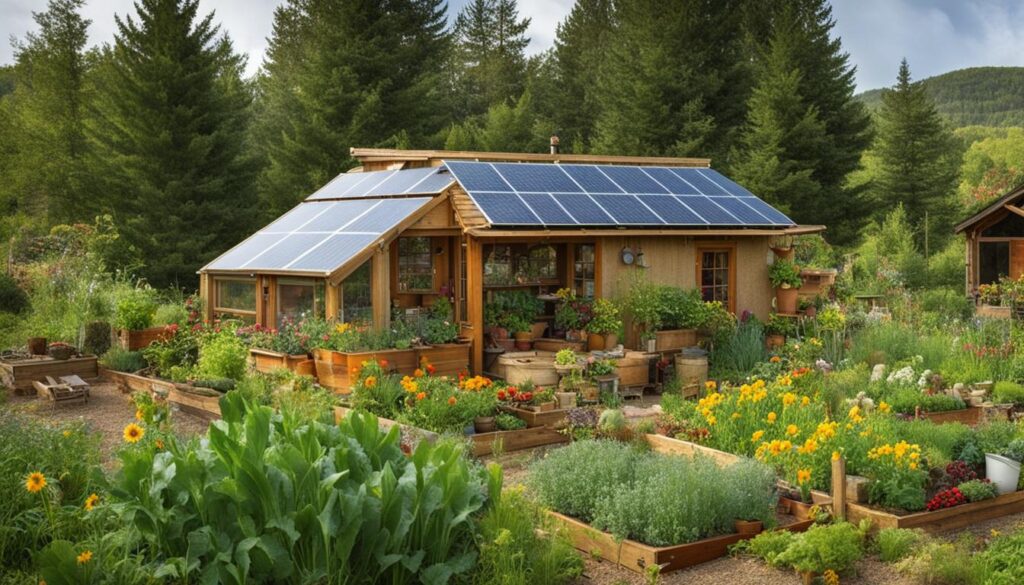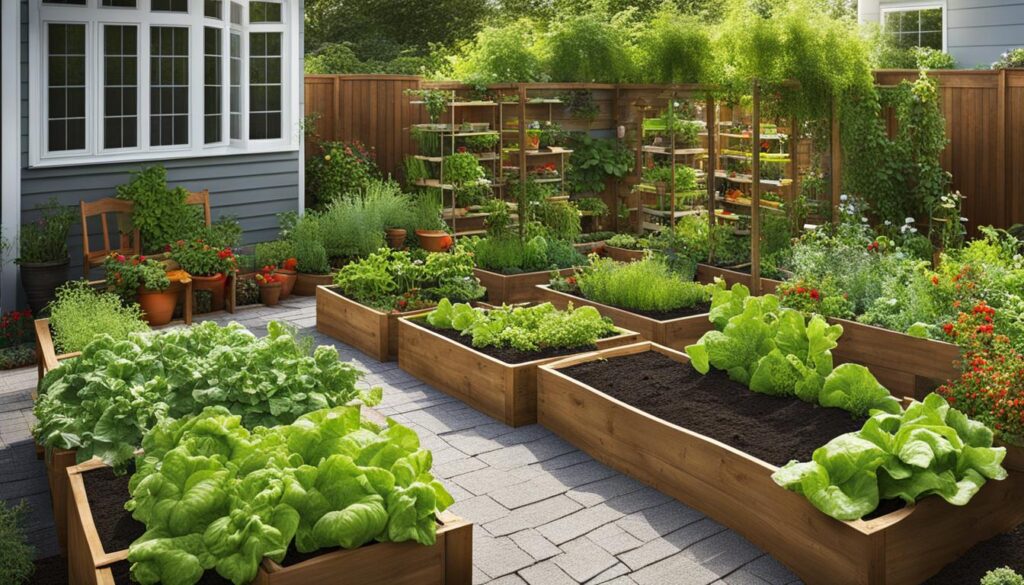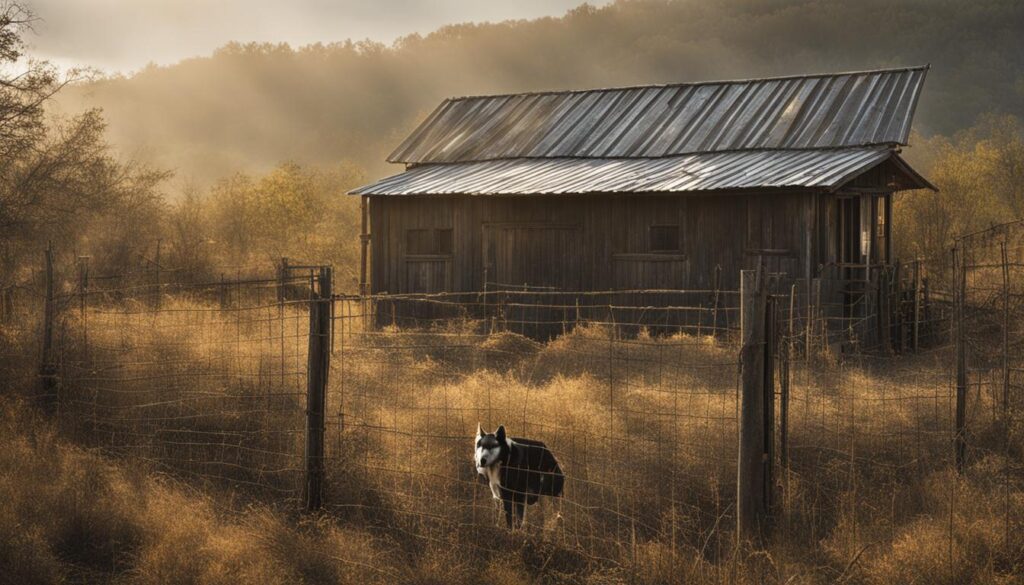
When it comes to ensuring the safety of your prepper retreat, homestead self-defense should be a top priority. Whether you have a small bugout location or a larger homestead, implementing a solid defense plan is essential for your survival in a post-apocalyptic scenario. The key is to understand what you need to protect and create a layered defense system tailored to your specific needs.
First and foremost, establish a prioritized list of items that require protection. This includes your own safety and that of your family, as well as your home, water supply, livestock, fuel and wood supply, garden, barn and outbuildings, and greenhouse. By identifying these key areas, you can effectively allocate resources and devise strategies to safeguard them.
Once you have determined what needs to be protected, it’s time to evaluate your property for vulnerabilities. Look for weak points in your perimeter and consider ways to fortify them. This can involve setting up listening posts and observation posts around your property, training guard dogs, and employing camouflage techniques to blend in with the surrounding environment. By implementing these defensive measures, you can enhance your security and increase your chances of survival.
Key Takeaways:
- Prioritize the areas that need protection, including your safety, home, water supply, livestock, fuel and wood supply, garden, barn and outbuildings, and greenhouse.
- Evaluate your property for vulnerabilities and implement a layered defense system.
- Create listening posts and observation posts to enhance early warning and surveillance capabilities.
- Train guard dogs and utilize camouflage techniques to blend in with the environment.
- By implementing these measures, you can increase the security of your prepper retreat and improve your chances of survival.
Perimeter Defense Priorities
When it comes to securing your homestead and ensuring the safety of your prepper retreat, it is crucial to prioritize various aspects of your perimeter defense plan. By carefully considering and addressing the following areas, you can enhance the overall security of your property:
Safety of Yourself and Your Family
Your first and foremost priority should be the safety of yourself and your loved ones. Implement measures to protect your family members, including establishing safe areas within your home and having emergency plans in place.
Securing Your Home
Next, focus on fortifying your home against potential threats. This includes reinforcing doors and windows, installing security systems, and implementing measures to deter intruders.
Ensuring a Stable Water Supply
Water is essential for survival. Take steps to secure a reliable water source, establish water storage systems, and consider implementing filtration and purification methods.
Protecting Livestock
If you have livestock on your property, it is crucial to ensure their safety and well-being. This may involve constructing sturdy fences, implementing animal monitoring systems, and considering backup plans for their care in case of emergencies.
Maintaining a Fuel Supply
In a self-reliant homestead, having access to fuel is vital for cooking, heating, and transportation. Set up storage systems and consider alternative fuel sources such as firewood, propane, or solar power.
Securing Wood for Heating
For those relying on wood-burning stoves for heating, it is important to have a sustainable supply of firewood. Develop a plan for harvesting, storing, and protecting your wood source.
Protecting Your Garden, Barn, and Outbuildings
For self-sufficiency and food security, protecting your garden from pests and unauthorized access is crucial. Implement fencing, utilize deterrents, and consider utilizing natural barriers to safeguard your crops. Additionally, secure your barn and outbuildings to protect equipment, tools, and animal feed.
Safeguarding Your Greenhouse
A greenhouse can provide your homestead with a year-round food source. Implement measures to protect it from extreme weather conditions, secure entrances, and consider backup heating and watering systems.
By addressing these perimeter defense priorities, you can significantly enhance the safety and security of your prepper retreat. Taking proactive measures to secure your homestead will provide peace of mind and help ensure the long-term survivability of you and your loved ones.
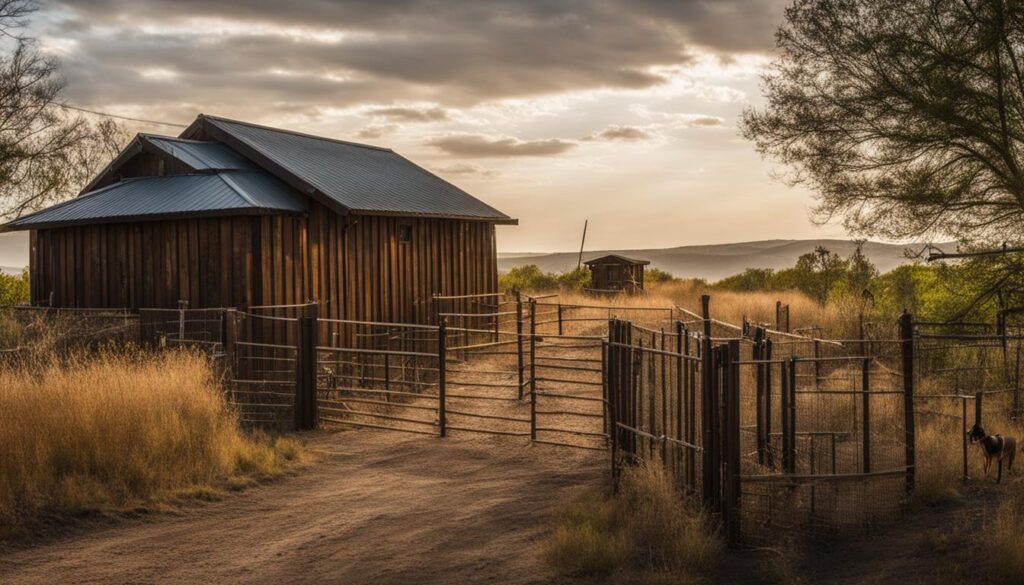
LP/OPs and Covert Structures
Creating listening posts (LPs) and observation posts (OPs) around the perimeter of my property is a key strategy for defending my prepper retreat. These covert or environment/society blended structures offer sightlines not only around my property but also of nearby roadways and neighborhoods.
LPs and OPs serve multiple purposes; they can also serve as temporary living quarters for members of my survival tribe. I ensure they are stocked with necessary survival gear, tools, and long-term storage food to support the individuals stationed there. Additionally, I consider burying a survival cache nearby, and I vent the roof for a camping stove to provide warmth and sustenance.
Creating LPs and OPs requires strategic positioning and blending them in with the surroundings to avoid attracting attention. They provide early warning and surveillance capabilities, giving me a tactical advantage in defending my prepper compound.
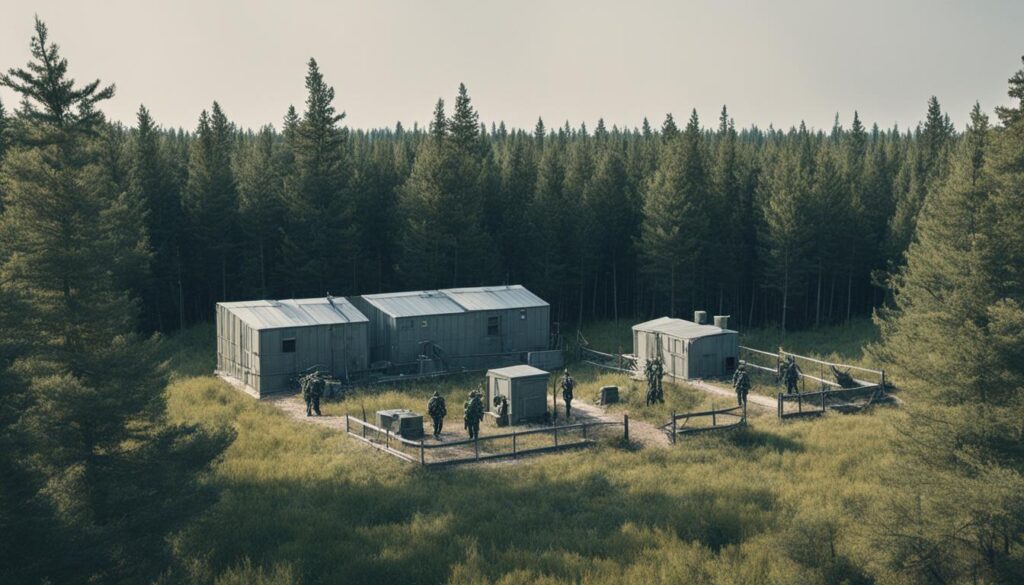
A Quote on Strategic Positioning
“Positioning LPs and OPs strategically plays a vital role in detecting potential threats and providing early warning. They allow for comprehensive surveillance of the surrounding area and ensure maximum security for your prepper retreat.”
– Daryl Thompson, Survival Expert
Advantages of LPs and OPs for Rural Self-Defense
LPs and OPs offer several advantages for rural self-defense strategies:
- Early detection of potential threats
- Enhanced surveillance of the surrounding area
- Strategic alert system for the entire compound
- Temporary shelter for survival tribe members
- Stocking survival gear, tools, and long-term storage food
By incorporating LPs and OPs into my defense plan, I increase the overall security of my prepper compound and boost my chances of successfully defending against potential threats.
Protecting Your Property vs. Defending Your Home
When it comes to self-defense, it is vital to understand the distinction between protecting your property and defending your home. While defending your home involves repelling intruders and utilizing home defense tactics, protecting your homestead encompasses a broader scope of safeguarding. This includes ensuring the security of your land, crops, livestock, physical home, and other valuable assets. Defending a larger parcel of land, especially in a SHTF (Shit Hits The Fan) event where the rule of law may be unreliable or absent, requires a different tactical approach.
The ultimate goal in defending your homestead is to establish and maintain a perimeter around your property, effectively keeping any potential threats, whether human or unknown, outside that boundary. By doing so, you maximize your safety and minimize vulnerabilities. It is crucial to keep potential threats at a distance, preventing them from breaching your property’s defenses and jeopardizing your well-being.
Preparing for self-defense on a homestead involves implementing a multi-layered security strategy tailored to the specific features of your property. This approach not only accounts for the defense of your physical home but also takes into consideration the protection of the surrounding land, crops, livestock, and other critical resources.
Defending Your Home
Defending your home is focused on protecting your immediate living space, ensuring the safety of yourself, your family, and your belongings within the confines of your residence. It involves utilizing various home defense tactics, such as fortifying doors and windows, installing a security system, and being ready to respond to any potential threats.
Remember, defending your home is just one aspect of overall homestead self-defense. To truly protect your prepper retreat, it is crucial to extend your security measures beyond the walls of your home.
Protecting Your Property
Protecting your property, on the other hand, requires a broader perspective and a more encompassing approach. It involves implementing measures to secure the entire perimeter of your homestead, including fences, gates, and surveillance systems. Additionally, strategic landscape design with natural barriers and defensive vegetation can act as a deterrent for would-be intruders.
By focusing on protecting your property as a whole, you create a buffer zone that helps keep potential threats away from your immediate living space.
Minimizing Vulnerabilities
To ensure comprehensive self-defense, it is crucial to identify and address vulnerabilities in both your home and property defense strategies. Assess your homestead for any weak points that may compromise your security. Alternatively, seek professional advice to gain valuable insights into optimizing your defense measures.
Remember, defending your homestead is not about instigating conflict but about preventing it. By implementing an effective security plan, you significantly reduce the likelihood of your property being targeted.
Defending your home and protecting your property go hand in hand. By taking a holistic approach to your homestead self-defense, you can enhance your overall security and increase your chances of surviving potential threats.
| Defending Your Home | Protecting Your Property | |
|---|---|---|
| Objective | Protect your immediate living space and belongings within your home | Secure the entire perimeter of your homestead, including land, crops, and resources |
| Foci | Home defense tactics, fortifying doors and windows, installing a security system | Perimeter security, fences, gates, surveillance systems, natural barriers |
| Impact | Immediate protection for yourself, your family, and your possessions | Preventing potential threats from breaching your property and compromising safety |
| Ultimate Goal | Repelling intruders and keeping your personal space secure | Maintaining a buffer zone to deter potential threats from reaching your home |
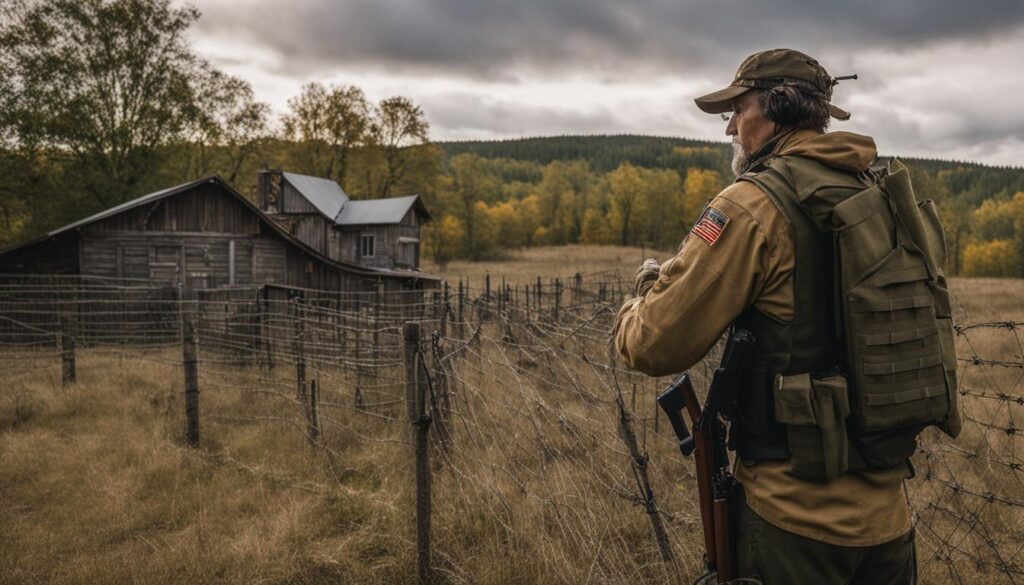
Choosing Effective Firearms
When it comes to self-defense techniques and defending a prepper compound, selecting the right firearms is crucial. Factors such as range and accuracy should be carefully considered to ensure the effectiveness of your defense strategy.
For close-range self-defense, handguns are a suitable choice. They offer maneuverability and ease of use in confined spaces. However, when defending a larger property like a prepper compound, a long gun such as a rifle or shotgun may be necessary to reach targets at longer distances.
I recommend the following options:
- Rifle: A scoped rifle is ideal for properties with broad sightlines and fewer obstructions. The scope allows for precise targeting, making it an effective weapon for long-range engagements.
- Shotgun: A shotgun is best suited for shorter sightlines and closer encounters. Its spread of projectiles makes it highly effective at close to medium ranges, providing a wider target area for self-defense.
Remember, regardless of the type of firearm you choose, it is essential to become proficient in its operation. Regular training and practice will ensure you can effectively use these weapons under the stress of a self-defense situation.
Furthermore, stockpiling an ample supply of ammunition is essential to sustain your defense capabilities. Make sure you have enough rounds to meet your needs and consider investing in reloading equipment for long-term sustainability.
| Rifle | Shotgun | |
|---|---|---|
| Range | Longer distances | Short to medium ranges |
| Precision | High | Moderate |
| Spread/Area Coverage | Minimal | Wider target area |
| Sightline Requirements | Fewer obstructions | Short sightlines |
Fortifying Your Home for SHTF
To fortify your home for a SHTF scenario, several measures can be taken. First, it is essential to maintain operational security (OPSEC) and avoid disclosing information about your preparedness supplies and resources. Revealing too much about your stockpile can make your home a target for looters and desperate individuals.
Camouflaging yourself and your home to blend in with the surroundings is another important step in prepper retreat safety. By disguising your property, you decrease the likelihood of attracting attention from outsiders. Consider using natural materials and earth-toned colors for your exterior, and avoid standing out in any way that could make you a potential target.
Creating a defensive perimeter around your property is a crucial aspect of rural security measures. Here are some effective strategies:
- Build sturdy fences: A strong fence acts as a physical barrier and sends a clear message that your property is off-limits. Use durable materials such as wood or metal, and consider adding barbed wire or other deterrents.
- Landscaping with thorny plants: Incorporate thorny bushes and plants along the perimeter of your property to create a natural deterrent. Examples include roses, holly bushes, and cacti.
- Utilize open space: Keep the area around your home clear of dense shrubs or trees that could provide cover for potential intruders. Maintaining a clear line of sight gives you the advantage of early detection.
- Hanging warning signs: Displaying signs indicating the presence of security measures, such as video surveillance or guard dogs, can deter trespassers.
In addition to physical barriers, incorporating security technology can further fortify your home. Consider these options:
- Security cameras: Install strategically placed security cameras to monitor the perimeter of your property. Visible cameras can act as a deterrent, while hidden cameras provide additional surveillance.
- Motion lights: Motion-activated lights around your property can startle potential intruders and draw attention to their presence.
- Reinforced doors: Upgrade your doors with solid-core construction, reinforced frames, and high-quality deadbolts. Consider installing a door reinforcement kit for extra strength.
- Secure windows: Reinforce windows with security film, install window locks, and consider adding window bars or shutters as additional barriers.
By implementing these rural security measures, you can significantly enhance your prepper retreat safety and increase your chances of withstanding a SHTF situation.
Example Table: Home Security Technologies
| Security Technology | Description |
|---|---|
| Security Cameras | Surveillance cameras provide visual monitoring of your property, deter potential criminals, and provide evidence if a crime occurs. |
| Motion Lights | Motion-activated lights illuminate your property when triggered, alerting you to potential threats and deterring trespassers. |
| Reinforced Doors | Upgraded doors with reinforced frames, solid-core construction, and high-quality locks offer greater resistance against forced entry. |
| Secure Windows | Window reinforcements such as security film, locks, bars, or shutters provide added protection against break-ins. |
Remember, fortifying your home is a critical aspect of prepping and should not be overlooked. By taking proactive steps to defend your property, you increase your chances of survival in a SHTF scenario.
Conclusion
In conclusion, ensuring homestead self-defense and protecting your prepper retreat are essential components of a comprehensive survival plan. By identifying the areas that require protection, establishing multiple layers of defense, and implementing effective security measures around your property, you significantly enhance your chances of survival. Additionally, carefully selecting appropriate firearms, fortifying your home, and maintaining operational security (OPSEC) are crucial considerations.
Remember that the primary objective is to maintain distance from potential threats and seamlessly blend into your surroundings to avoid drawing attention. By developing a well-thought-out self-defense strategy, you can significantly increase the safety and security of your prepper retreat.
In these uncertain times, it is imperative to prioritize the defense of your homestead and be prepared for any potential disruptions. By employing effective defense measures, you ensure the protection of your loved ones, property, and essential resources. Protecting your prepper retreat is not just a choice; it’s a necessity for the long-term sustainability of your survival plan.
FAQ
What should be prioritized in a perimeter defense plan for a prepper retreat?
It is important to prioritize what needs to be protected in your perimeter defense plan. This includes considering the safety of yourself and your family, securing your home, ensuring a stable water supply, protecting livestock, maintaining a fuel supply, securing wood for heating, protecting your garden, barn and outbuildings, and safeguarding your greenhouse. Failing to protect any of these areas could lead to a rapid decline in survival prospects.
What are listening posts (LPs) and observation posts (OPs), and why are they important for defending a prepper retreat?
LPs and OPs are structures positioned around the perimeter of your property that offer sightlines not only around your property but also of nearby roadways and neighborhoods. These covert or environment/society blended structures provide early warning and surveillance capabilities. They can also serve as temporary living quarters for members of your survival tribe and should be stocked with necessary survival gear, tools, and long-term storage food. LPs and OPs should blend in with their surroundings to avoid attracting attention.
What is the difference between protecting your property and defending your home?
Protecting your property involves safeguarding your land, crops, livestock, physical home, and other property. Defending your home goes beyond that and involves repulsing trespassers and engaging in home defense tactics. When it comes to a larger parcel of land, defending a prepper compound requires a different tactical approach, especially in a SHTF event where the rule of law is unreliable or absent. The goal is to maintain a perimeter around your property and keep any enemy or unknown person outside that perimeter to increase your safety and minimize vulnerabilities.
What factors should be considered when choosing firearms for defending a prepper retreat?
It is important to consider factors such as range and accuracy when choosing firearms for defending your homestead. Handguns are suitable for close-range self-defense, but for defending a larger property, a long gun such as a rifle or shotgun may be necessary. A scoped rifle is recommended for properties with broader sightlines and fewer obstructions, while a shotgun is more suitable for shorter sightlines and closer encounters. Proficiency in using your chosen firearms at the expected ranges and ensuring an adequate ammunition stockpile is crucial.
What security measures can be taken to fortify a home for a SHTF scenario?
To fortify your home for a SHTF scenario, several measures can be taken. Maintaining operational security (OPSEC) and avoiding disclosure of information about your preparedness supplies and resources is essential. Camouflaging yourself and your home to blend in with the surroundings can help avoid attracting attention. Creating a defensive perimeter around your property can be achieved through strategies like building fences, landscaping defensively with thorny plants, using open space to maintain a clear line of sight, and hanging warning signs. Installing security cameras, motion lights, reinforced doors, and secure windows also contribute to fortifying your home.

